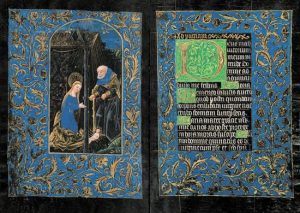The Book of Hours are a series of religious prayer books that were dominant during mid medieval times and onward. The Book of Hours were meant as personal bibles, that individuals could use to follow prayers and show their devotion without the need of an outside source such as a church. The book of hours themselves were considered a luxury item that mainly the wealthy could afford, namely the church and nobility. During the 1400s, the production of parchment (a processed piece of animal skin meant to be written on) was a tedious and very expensive task that was often used by the commissioners to produce these books. A certain lineage of the Book of Hours known as The Black Books of Hours became a milestone for beauty, extravagance, and luxury in the realm of medieval literature. Their folios consisted of black tinted vellum (an extremely fine piece of parchment: calfskin) that had a multitude of vivacious illuminations that mesmerized readers across the ages. An analysis of one of these iconic manuscripts’, Black Hours, materials such as pigmentation, and parchment quality along with the illuminations, demonstrate the social status of its patron.

The Black Hours’ black pigmented velum folios were utilized strategically to make its natural blue, gold, and silver colors stand out more. The major contrast between the full black and the vivacious colors such as green, gold, and red radiate a presence of luxury. By doing this, the viewer can assume that producing such a book was not an easy task, and certainly not a cheap one either. “It was a complicated, costly, and time-consuming job to manufacture skins for writing…” (Treharne 24). Since the Black Hours had its vellum pigmented black, it was even more costly and time-consuming to make. Ink such as gold, silver, and blue were amongst the most expensive, and rare colors during the middle ages. These colors were not easily affordable by the lower classes. Because the manuscript consists of 122 folios, this is indicative that this book was produced for someone with an extreme sum of money and that was fortunate enough to not only be wealthy but also literate. “But, as the centuries progressed noble secular households… became important patrons of and audiences for literature, often fostering an elite literate culture, and helping establish new forms of textual production” (Treharne 26). During the middle ages, it was uncommon for people other than the upper classes to be literate. The education in conjunction with the wealth, their influence on medieval texts is apparent. The Black Hours exemplifies the influence that some of the elite had on these manuscripts. The high amount of intricacy and detail that the manuscript employs with its consistent gold flower motifs throughout the book highlighted by the black stained vellum demonstrate that the individual, responsible for this manuscript, was a fan of the Gothic Style and intended for the book to reflect that through the border design and stained vellum. By staining the vellum black and producing a gothic theme, the commissioner of the Black Hours is revolutionizing religious texts by introducing his novelty.

The Black Hours also contains a total of 14 miniatures themed primarily around Christ and the Virgin. These miniatures not only highlight some of the most important events within Christian beliefs, but they also serve as a propaganda for devotion. On Folio 29v, the Virgin is seen kneeling beside an open bible while being visited by an angel. This can be seen as a form of propaganda for Christianity that encourages prayer. The visual claims that individuals who pray and read the bible will be visited by angels and be closer to heaven.

The relative size of the Black Hours is about 6.7×4.8 inches which was too small to be a book meant for public use. During medieval times, it was common for communities to gather and listen to texts being read. Additionally, these texts were large so that the visuals could be fully enjoyed by these masses of people that tended to not be literate. Therefore, its relative size indicates that the Black Hours was meant for private use by a religious individual or by a religious family, rather than at a church. Its size also points out that it was not common to come across such a luxurious book among the lower classes in this time.
The Black Hours touched boundaries that other medieval texts had not touched before. From the black stained vellum to the expensive gold, silver, and blue inks, this manuscript flexes the social status and preference of its patron. With the illuminations and decorations, the Black Hours was a luxurious book that spoke about the social construct around middle age literature. The analysis on the materiality of this medieval manuscript demonstrates that it was more than a religious text, the book also made various statements about the elite classes’ influence through texts.
Works Cited
“The Black Hours.” The Morgan Library & Museum. N.p., 13 Sept. 2017. Web.
All images of the Black Hours are taken from the online exhibition of this museum.
Treharne, Elaine M. Medieval Literature: A Very Short Introduction. N.p.: Oxford UP, 2015. Print.